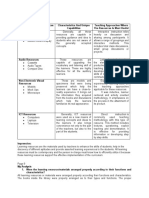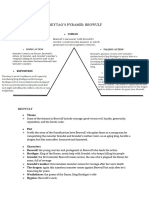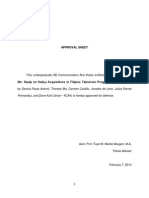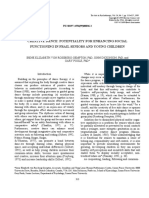0 ratings0% found this document useful (0 votes)
15 viewsTrends, Challenges and Its Solutions.
Trends, Challenges and Its Solutions.
Uploaded by
Eric AgayaoThe document discusses current trends, challenges, and solutions in teaching Technology and Livelihood Education (TLE). Key trends include synchronous and asynchronous learning delivery methods. Challenges involve unreliable internet access, lack of student-teacher interaction, and difficulties adapting to self-paced learning. Solutions proposed are providing alternative learning materials for students without internet, breaking courses into bite-sized modules, and incorporating hands-on demonstrations and work immersion. The pandemic has disrupted traditional work immersion programs, necessitating alternative approaches like home visits and on-campus laboratory sessions.
Copyright:
© All Rights Reserved
Available Formats
Download as DOCX, PDF, TXT or read online from Scribd
Trends, Challenges and Its Solutions.
Trends, Challenges and Its Solutions.
Uploaded by
Eric Agayao0 ratings0% found this document useful (0 votes)
15 views3 pagesThe document discusses current trends, challenges, and solutions in teaching Technology and Livelihood Education (TLE). Key trends include synchronous and asynchronous learning delivery methods. Challenges involve unreliable internet access, lack of student-teacher interaction, and difficulties adapting to self-paced learning. Solutions proposed are providing alternative learning materials for students without internet, breaking courses into bite-sized modules, and incorporating hands-on demonstrations and work immersion. The pandemic has disrupted traditional work immersion programs, necessitating alternative approaches like home visits and on-campus laboratory sessions.
Copyright
© © All Rights Reserved
Available Formats
DOCX, PDF, TXT or read online from Scribd
Share this document
Did you find this document useful?
Is this content inappropriate?
The document discusses current trends, challenges, and solutions in teaching Technology and Livelihood Education (TLE). Key trends include synchronous and asynchronous learning delivery methods. Challenges involve unreliable internet access, lack of student-teacher interaction, and difficulties adapting to self-paced learning. Solutions proposed are providing alternative learning materials for students without internet, breaking courses into bite-sized modules, and incorporating hands-on demonstrations and work immersion. The pandemic has disrupted traditional work immersion programs, necessitating alternative approaches like home visits and on-campus laboratory sessions.
Copyright:
© All Rights Reserved
Available Formats
Download as DOCX, PDF, TXT or read online from Scribd
Download as docx, pdf, or txt
0 ratings0% found this document useful (0 votes)
15 views3 pagesTrends, Challenges and Its Solutions.
Trends, Challenges and Its Solutions.
Uploaded by
Eric AgayaoThe document discusses current trends, challenges, and solutions in teaching Technology and Livelihood Education (TLE). Key trends include synchronous and asynchronous learning delivery methods. Challenges involve unreliable internet access, lack of student-teacher interaction, and difficulties adapting to self-paced learning. Solutions proposed are providing alternative learning materials for students without internet, breaking courses into bite-sized modules, and incorporating hands-on demonstrations and work immersion. The pandemic has disrupted traditional work immersion programs, necessitating alternative approaches like home visits and on-campus laboratory sessions.
Copyright:
© All Rights Reserved
Available Formats
Download as DOCX, PDF, TXT or read online from Scribd
Download as docx, pdf, or txt
You are on page 1of 3
CURRENT TRENDS, CHALLENGES AND POSSIBLE
SOLUTIONS IN TEACHING TLE
July 31, 2022
ERIC B. AGOYAO
TRENDS CHALLENGES SOLUTIONS
1. Delivery of Synchronous In the application of Teachers should also equip
Learning Synchronous Learning, one him/herself with the use of
of the challenges is the online applications as part of
internet connection. Also, teaching. However, to make
reliance on technology of this happen, teachers should
which it has been a major enlighten the minds of the
problem in this delivery parents about the existing
where some of the students problems that we have
don’t have access to this nowadays and give them
mode of delivery to cope with positive perceptions of the
the learning process. use of online learning. If
Students may not also receive other students don’t have the
the same attention if other capacity to learn by means of
students are also in need. online then record what has
The learning pace is set by been transpired in the
the teacher and not the discussion and when there are
students. online activities, make sure
Much of the learning depends that you could also print out
on the quality of the teacher. the same activities which will
Both the students and be given to those earners.
teachers have to adhere to the
same time schedules in order
to equally execute the lesson.
2. Delivery of Asynchronous There is only limited access Make use of your own
Learning to the teacher and/or get modules based on the most
answers in real-time. essential learning of your
Some students may struggle students since you have the
w/o proper guidance and full access in honing their
interaction. skills and in shaping their
Not all instructions are best knowledge at least in this way
suited for self-paced learning. you know what are their least
mastered competencies.
Make your own design
intuitive and user-friendly
and break the eLearning
course into bite-size modules
because they are learners are
not fun enough in reading and
sit through an hour-long
learning session.
3. Teachers always showcase Students may not learn much Let your learners have always
the actual performance because as we all know we a return demo for them to
through demonstration. can learn better when doing experience its actual-based
it. performance to them to easily
learn what is expected
outcome and have the best
quality.
4. Development of Despite the fact that the speed To catch up with the trends of
technologies and business of progress in the these new technologies,
models instruction area is for the teachers should involve and
most part slower engage the students with the
then in other more benefit- help of partner agencies that
driven could enhance their skills and
area, plan of action knowledge,particularly in the
development is newly emerged technologies,
turning out to be always. As and make them experience
such the the process. And since our
instruction scene is bound to students are under Home
change essentially in the Economics we let them have
following their Work Immersion in the
a long time as new actors different agencies that ccater
shake-up to their field of specialization
customary advanced in order for them to gain
education and more knowledge and develop
long-lasting learning models. their skills into actual work.
For quick
developing pioneers in
instructive
innovations and instruction
industry
pariahs are as of now testing
the
status quo by basically
subverting
the long-settled plans of
action
of advanced education. These
new actors
use innovation and
information present
new, elective methodologies
that
better follow through on
advancing assumptions
of students.
5. The practice of Work Because of the pandemic, this We do home visitation and
Immersion in the teaching program has been stopped also we make a schedule to
process of Bread and Pastry and left marks in the history have their laboratory
Production. of teaching. From an actual activities inside the school’s
work immersion to the laboratory to have proper
partner institutions to Home- guidance and instructions and
based work immersion a chance for them to be
became a challenge in the familiarized with the tools
Deped. and equipment that are being
used in the baking.
You might also like
- EDU 586 - Models of Professional Development Matrix - PDFDocument5 pagesEDU 586 - Models of Professional Development Matrix - PDFshirley moligaNo ratings yet
- Professional Development PlanDocument8 pagesProfessional Development PlanLovely Airomlav100% (2)
- Portfolio in Technology For Teaching and Learning 2Document31 pagesPortfolio in Technology For Teaching and Learning 2Paniza, Tracy Kieth Marie100% (1)
- Asset Management PAS 55 ISO 55000Document15 pagesAsset Management PAS 55 ISO 55000Prathap Selvam100% (1)
- Frameworks Theories Comparison ChartDocument4 pagesFrameworks Theories Comparison Chartapi-532923752100% (1)
- Instructional Delivery MethodsDocument3 pagesInstructional Delivery Methodsapi-3770163100% (4)
- Field Study 3 - Answers (2015)Document20 pagesField Study 3 - Answers (2015)Celine Amparo77% (108)
- Hach Nitrate Method 10206 Final 01102013Document10 pagesHach Nitrate Method 10206 Final 01102013dunavko1No ratings yet
- Apple Computer Inc. (Case Study)Document15 pagesApple Computer Inc. (Case Study)salugee81% (16)
- Professional Self-Assessment Questionnaire: Module 4: Planning For Continuing Professional Development and Lac PlanningDocument8 pagesProfessional Self-Assessment Questionnaire: Module 4: Planning For Continuing Professional Development and Lac PlanningClaudine Marmol100% (1)
- AsessementtttDocument4 pagesAsessementtttMaria Faye ZaraNo ratings yet
- My 21st Century Classroom Facilitating SkillsDocument2 pagesMy 21st Century Classroom Facilitating SkillsNitaflor GanioNo ratings yet
- EP 13 UpdatedDocument4 pagesEP 13 UpdatedBae Kellah Kassandra LandaweNo ratings yet
- Cadaa - Module 4 - EDUC 126Document6 pagesCadaa - Module 4 - EDUC 126Elfe Grace L. CadaaNo ratings yet
- Ijper 106 21-QCRDDocument7 pagesIjper 106 21-QCRDSmriti IndoreNo ratings yet
- Edl273 CeihoeksemaDocument3 pagesEdl273 Ceihoeksemaapi-361639521No ratings yet
- D1 S1 Breakout Room ActivityDocument4 pagesD1 S1 Breakout Room ActivityArnel Martinez GaudiaNo ratings yet
- Lesson Plan TTL Executive BranchDocument4 pagesLesson Plan TTL Executive Branchjesan villaceranNo ratings yet
- Online Teaching and Learning ChallengesDocument2 pagesOnline Teaching and Learning ChallengesShez MerchantNo ratings yet
- Uas - EnggrisDocument17 pagesUas - EnggrisZefanya SherafimNo ratings yet
- CPD PlanDocument1 pageCPD PlanRoe Francis TabagoNo ratings yet
- Key Pedagogical TermsDocument4 pagesKey Pedagogical Termsashusol2015No ratings yet
- Emerging Trends in Teacher EducationDocument5 pagesEmerging Trends in Teacher EducationMuhammad Akram100% (1)
- Education 4.0: A Paradigm ShiftDocument46 pagesEducation 4.0: A Paradigm Shiftmanishaamba7547No ratings yet
- Preparations On Becoming A Practice TeacherDocument7 pagesPreparations On Becoming A Practice Teachermaela pollen yemaNo ratings yet
- Kami Export - Online Classes Give Positive or Negative Impact NewsletterDocument8 pagesKami Export - Online Classes Give Positive or Negative Impact NewsletterTheresa MarionNo ratings yet
- LDM2 Final 4A As of Dec. 9 2020Document5 pagesLDM2 Final 4A As of Dec. 9 2020hazelkia adrosallivNo ratings yet
- Synthesis Paper No.1Document4 pagesSynthesis Paper No.1Josel Gigante Caraballe0% (1)
- Zefanya Sherafim - Power Point UAS - Paper Ulization of Learning Technology in The Context of Modern Education-CompressedDocument17 pagesZefanya Sherafim - Power Point UAS - Paper Ulization of Learning Technology in The Context of Modern Education-CompressedZefanya SherafimNo ratings yet
- Iste Readiness Assessment 1Document7 pagesIste Readiness Assessment 1api-534384834No ratings yet
- Zefanya Sherafim - Power Point UAS - Paper Ulization of Learning Technology in The Context of Modern EducationDocument17 pagesZefanya Sherafim - Power Point UAS - Paper Ulization of Learning Technology in The Context of Modern EducationZefanya SherafimNo ratings yet
- Episode 13 " Utilizing Application (Apps) For Teaching and Learning"Document7 pagesEpisode 13 " Utilizing Application (Apps) For Teaching and Learning"Reden Alicom100% (1)
- EED-12-REVIEWER_010800Document3 pagesEED-12-REVIEWER_010800alliahmar1704No ratings yet
- MODULE 4 AnswerDocument4 pagesMODULE 4 AnswerWenelyn BautistaNo ratings yet
- Cit Colleges of Paniqui Foundation Inc.: Burgos Blvd. Poblacion Norte, Paniqui, TarlacDocument6 pagesCit Colleges of Paniqui Foundation Inc.: Burgos Blvd. Poblacion Norte, Paniqui, TarlacAlvin Corpuz JrNo ratings yet
- Teaching Internship Learning Task 1Document7 pagesTeaching Internship Learning Task 1Gia AlmirañezNo ratings yet
- Designing Instruction in The Different Learning Delivery ModalitiesDocument9 pagesDesigning Instruction in The Different Learning Delivery ModalitiesAmy GrantNo ratings yet
- EDUC 3 Acivity 11Document5 pagesEDUC 3 Acivity 11Alvin Corpuz JrNo ratings yet
- ACTIVITYDocument3 pagesACTIVITYGellirose S. BantayanNo ratings yet
- Teacher Evaluation Rubric For Use of TechnologyDocument3 pagesTeacher Evaluation Rubric For Use of Technologyapi-676530090No ratings yet
- Fs2-Activity 3Document7 pagesFs2-Activity 3Charles Edward BacaniNo ratings yet
- InfographicDocument2 pagesInfographicAnyi HernándezNo ratings yet
- Anzano Activity 4Document4 pagesAnzano Activity 4Irene AnzanoNo ratings yet
- My 21st Century Classroom Facilitating SkillsDocument5 pagesMy 21st Century Classroom Facilitating Skillscindy laraNo ratings yet
- Narrative Report-Inset Dec-2020Document5 pagesNarrative Report-Inset Dec-2020CHERRY ROSE CREENCIANo ratings yet
- Standard 1Document2 pagesStandard 1api-450801939No ratings yet
- 4.-LMD2 - Module4 Template LND MAPEH NEWDocument10 pages4.-LMD2 - Module4 Template LND MAPEH NEWmeriam.nool002No ratings yet
- CHAPTER 2: Integration of Technology in InstructionDocument13 pagesCHAPTER 2: Integration of Technology in InstructionSheene DivaNo ratings yet
- Describing T StrategiesDocument6 pagesDescribing T StrategiesJHON ARISTOTLE E MIQUENo ratings yet
- CSTP 1 Haro 12 12 19Document9 pagesCSTP 1 Haro 12 12 19api-467608657No ratings yet
- Answer for video NoDocument2 pagesAnswer for video Noarnel.polpero001No ratings yet
- Individual Development PlanDocument3 pagesIndividual Development PlanMARLON SICAT100% (1)
- Guidelines For Blended Learning 2.0Document24 pagesGuidelines For Blended Learning 2.0fadhilasnawiNo ratings yet
- Individual Development Plan: A. Functional Competencies 1. Content Knowledge and PedagogyDocument3 pagesIndividual Development Plan: A. Functional Competencies 1. Content Knowledge and PedagogyBlu MarlenesNo ratings yet
- The Lesson Plan That You Prepare Is The One You Will Use in Your Actual Delivery of The LessonDocument3 pagesThe Lesson Plan That You Prepare Is The One You Will Use in Your Actual Delivery of The Lessonlyka marianoNo ratings yet
- Carillas, Mishil (Models Ofcurriculum Development)Document6 pagesCarillas, Mishil (Models Ofcurriculum Development)Mishil CarillasNo ratings yet
- 2018 Usability Evaluation of Confirm-A Learning Tool Towards Education 4.0 PDFDocument6 pages2018 Usability Evaluation of Confirm-A Learning Tool Towards Education 4.0 PDFDr. Azree IdrisNo ratings yet
- Edu 609 D 8Document7 pagesEdu 609 D 8api-610591673No ratings yet
- Classroom Flipping As The Basis of A Teaching Model For The CourseDocument4 pagesClassroom Flipping As The Basis of A Teaching Model For The CourseRahmat IlahiNo ratings yet
- Amity Institute of Education: Seven-Day Faculty Development Programme On "Document2 pagesAmity Institute of Education: Seven-Day Faculty Development Programme On "Kashish GuptaNo ratings yet
- Fs 3 Episode 1Document8 pagesFs 3 Episode 1Mark Anthony Nieva RafalloNo ratings yet
- Darling-Hammond, L. 2006. Constructing 21st-century Teacher Education. Journal of Teacher Education. 57(10). pp. 1-15.Document16 pagesDarling-Hammond, L. 2006. Constructing 21st-century Teacher Education. Journal of Teacher Education. 57(10). pp. 1-15.Yến TrầnNo ratings yet
- School Form 2 (SF 2)Document3 pagesSchool Form 2 (SF 2)Eric AgayaoNo ratings yet
- Set B - Aswer KeyDocument6 pagesSet B - Aswer KeyEric AgayaoNo ratings yet
- Eric B. Agoyao - Review Related Literature (Philosopy of Education)Document12 pagesEric B. Agoyao - Review Related Literature (Philosopy of Education)Eric AgayaoNo ratings yet
- BNAS Mass Induction Program ScriptDocument3 pagesBNAS Mass Induction Program ScriptEric AgayaoNo ratings yet
- Quiz No 1Document3 pagesQuiz No 1Eric AgayaoNo ratings yet
- MAPEH 10 4th VALUESDocument2 pagesMAPEH 10 4th VALUESJunrel SapantaNo ratings yet
- Invoice PDFDocument1 pageInvoice PDFKalpesh TomarNo ratings yet
- Grade 1 Story Elements ADocument3 pagesGrade 1 Story Elements AVendettaNo ratings yet
- Polynomials YCMADocument13 pagesPolynomials YCMAAnan LeeNo ratings yet
- Archeological Ceramics PDFDocument292 pagesArcheological Ceramics PDFjuliocsierra2971No ratings yet
- Towards Bagumbayan: New Town, Killing GroundDocument45 pagesTowards Bagumbayan: New Town, Killing GroundSteve B. SalongaNo ratings yet
- Epfl Chapter 7Document18 pagesEpfl Chapter 7ioanciorneiNo ratings yet
- Macroeconomics Test #1 (Ch. 5:6) Flashcards - QuizletDocument10 pagesMacroeconomics Test #1 (Ch. 5:6) Flashcards - QuizletElizabeth Alarcón-GaxiolaNo ratings yet
- AKMAD, Sherralizah Nyra Bsmt3A: RBC (Red Blood Cell) Methods of Testing Procedure Reference ValuesDocument3 pagesAKMAD, Sherralizah Nyra Bsmt3A: RBC (Red Blood Cell) Methods of Testing Procedure Reference ValuesBainasria MaligaNo ratings yet
- FREYTAGDocument3 pagesFREYTAGChelsy Kate CastigonNo ratings yet
- Outline of Physical ScienceDocument15 pagesOutline of Physical ScienceASDNo ratings yet
- Xmas Party PrayerDocument4 pagesXmas Party PrayerPerzi Val100% (1)
- Surveying: Department of Civil Engineering NIT RourkelaDocument92 pagesSurveying: Department of Civil Engineering NIT Rourkelarodej54503No ratings yet
- This Content Downloaded From 77.97.129.131 On Thu, 26 Oct 2023 13:49:18 +00:00Document24 pagesThis Content Downloaded From 77.97.129.131 On Thu, 26 Oct 2023 13:49:18 +00:00Jack WaltonNo ratings yet
- Mix VarianceDocument1 pageMix VarianceClaire BarrettoNo ratings yet
- Galle FortDocument4 pagesGalle Fortsdkd29No ratings yet
- 2011 Baeza Garcia Tent Journal of Iberian GeologyDocument15 pages2011 Baeza Garcia Tent Journal of Iberian GeologyLuis AndresNo ratings yet
- United States v. Edgar Jamal Gamory, 11th Cir. (2011)Document31 pagesUnited States v. Edgar Jamal Gamory, 11th Cir. (2011)Scribd Government DocsNo ratings yet
- Usana CellsentialsDocument13 pagesUsana CellsentialsAj FarrellNo ratings yet
- APA Style ResultsDocument3 pagesAPA Style ResultsgedleNo ratings yet
- Common Cause (A Regd. Society) V. Union of IndiaDocument12 pagesCommon Cause (A Regd. Society) V. Union of IndiaNaman MishraNo ratings yet
- Fear No More The Heat of The Sun When in DisgraceDocument10 pagesFear No More The Heat of The Sun When in Disgrace10nov1964No ratings yet
- Annyeong Gusto MoDocument104 pagesAnnyeong Gusto MoJulius Payáwal Fernández0% (1)
- Ariel Salleh - Moving To An Embodied MaterialismDocument6 pagesAriel Salleh - Moving To An Embodied MaterialismaascherlNo ratings yet
- L2 CFA Notes 1Document64 pagesL2 CFA Notes 1simmbNo ratings yet
- Christology New Lesson ForDocument7 pagesChristology New Lesson ForChrisma SalamatNo ratings yet
- 23 Creative Dance Potentialy For Enhancing Social FunctioningDocument17 pages23 Creative Dance Potentialy For Enhancing Social FunctioningLuisa Fernanda Mondragon TenorioNo ratings yet






























































































